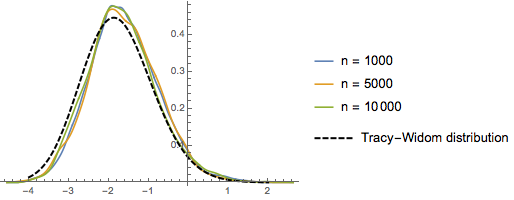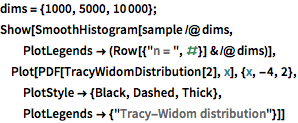Longest Increasing Subsequences
The number of permutations  of
of  elements in which the longest increasing subsequence is at most of length
elements in which the longest increasing subsequence is at most of length  can be computed by averaging over
can be computed by averaging over  , where
, where  are matrices drawn from CircularUnitaryMatrixDistribution of dimension
are matrices drawn from CircularUnitaryMatrixDistribution of dimension  .
.
In[1]:=
{k, n} = {6, 2};Define the matrix property distribution and calculate the mean.
In[2]:=

\[ScriptCapitalD] =
MatrixPropertyDistribution[Abs[Tr[\[ScriptCapitalU]]]^(
2 k), \[ScriptCapitalU] \[Distributed]
CircularUnitaryMatrixDistribution[n]];
N[Mean[\[ScriptCapitalD]]]Out[2]=
Compare with the direct count.
In[3]:=
Count[Permutations[Range[k]],
perm_ /; Length[LongestOrderedSequence[perm]] <= n]Out[3]=
For  , the distribution of the scaled lengths of the longest increasing subsequences of random permutations converges to the Tracy–Widom distribution with
, the distribution of the scaled lengths of the longest increasing subsequences of random permutations converges to the Tracy–Widom distribution with  .
.
In[4]:=

sample[n_] :=
1/n^(1/6) (Table[
Length[LongestOrderedSequence[
RandomSample[Range[n]]]], {2000}] - 2.0 Sqrt[n]);Compare the smooth histogram of sampled scaled lengths for increasing dimensions with the PDF of the Tracy–Widom distribution.
show complete Wolfram Language input
Out[5]=

























